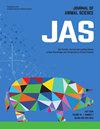PS-8验证使用数据记录器来测量丘陵地形上一岁安格斯公牛的站立行为
IF 2.7
2区 农林科学
Q1 AGRICULTURE, DAIRY & ANIMAL SCIENCE
引用次数: 0
摘要
本研究的目的是评估HOBO Pendant G加速度计数据记录器(Onset Computer Corporation, Bourne, Massachusetts, USA)在测量具有平坦和倾斜地形的围栏中一岁公牛站立和躺卧行为的可靠性。研究对象为26头安格斯公牛,选取6头焦点公牛。数据在两个独立的2周疗程中收集(总共4周)。在此期间,加速度计每隔1分钟在y轴上记录腿部方向,以确定站立和躺卧的时间。为了验证加速度计数据,进行了35次现场观察。每次现场观察都集中在一头公牛身上。训练有素的观察员注意到公牛是站着还是躺着,以及公牛在围栏中的位置(在山上或平坦的地形上),每隔1分钟扫描一次,持续3小时。使用RStudio (R version 3.6.0)进行数据分析。进行Spearman相关检验,将观察到的站立行为与加速度计数据进行比较。计算了整个数据集以及个别地形类型(平坦和丘陵)的相关性。所有观测值的站立时间与加速度计站立时间的相关系数r为0.92,呈较强的正相关。对于山地站立行为的分析,相关性增加到r = 0.95,而在平坦地形上,相关性仍然很高,r = 0.92。这些结果表明,Hobo Pendant G加速度数据记录器在不同地形类型的围栏中跟踪站立和躺卧行为是可靠的。本文章由计算机程序翻译,如有差异,请以英文原文为准。
PS-8 Validating the use of dataloggers to measure standing behavior of yearling Angus Bulls on hilly terrain
The goal of this study was to evaluate the reliability of the HOBO Pendant G Accelerometer Datalogger (Onset Computer Corporation, Bourne, Massachusetts, USA) in measuring standing and lying behavior of yearling bulls in a pen with both flat and sloped terrain. The study was conducted with 6 focal bulls selected from a pen of 26 Angus bulls. Data were collected during two separate 2-week sessions (4 weeks total). During this period, the accelerometers recorded leg orientation in the y-axis at 1-minute intervals to determine time spent standing and lying. To validate the accelerometer data, 35 in-person observational sessions were conducted. Each live observation focused on one individual bull. Trained observers noted whether the bull was standing or lying as well as the bull’s location in the pen (on hill or flat terrain) using 1-minute scan sample intervals for 3 hours. Data analysis was conducted using RStudio (R version 3.6.0). Spearman correlation tests were performed to compare the observed standing behavior to the accelerometer data. The correlations were calculated for the entire dataset as well as for individual terrain types (flat and hill). The correlation coefficient (r) between observed standing time and accelerometer standing time was 0.92 for all observations, indicating a strong positive relationship. For the analysis of standing behavior on the hill, the correlation increased to r = 0.95, and on the flat terrain, it remained similarly high at r = 0.92. These results demonstrate that the Hobo Pendant G Acceleration Dataloggers are reliable for tracking standing and lying behavior in a pen with varying terrain types.
求助全文
通过发布文献求助,成功后即可免费获取论文全文。
去求助
来源期刊

Journal of animal science
农林科学-奶制品与动物科学
CiteScore
4.80
自引率
12.10%
发文量
1589
审稿时长
3 months
期刊介绍:
The Journal of Animal Science (JAS) is the premier journal for animal science and serves as the leading source of new knowledge and perspective in this area. JAS publishes more than 500 fully reviewed research articles, invited reviews, technical notes, and letters to the editor each year.
Articles published in JAS encompass a broad range of research topics in animal production and fundamental aspects of genetics, nutrition, physiology, and preparation and utilization of animal products. Articles typically report research with beef cattle, companion animals, goats, horses, pigs, and sheep; however, studies involving other farm animals, aquatic and wildlife species, and laboratory animal species that address fundamental questions related to livestock and companion animal biology will be considered for publication.
 求助内容:
求助内容: 应助结果提醒方式:
应助结果提醒方式:


